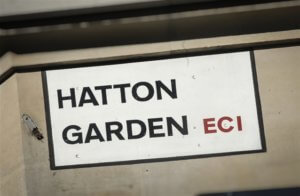Hatton Garden

The history of Hatton Garden is one with which the Watson family have been associated for many years. Vivian is now writing a book drawing on his experience, his relationships and his extensive collection of memorabilia.
The name Hatton Garden has been associated with diamonds, gems and jewellery for at least 150 years. The ‘Garden,’ as it is known to those who work there, is not so much of a single street but an area. Sir Christopher Hatton moved into Ely Palace with more than a little help from Queen Elizabeth and enjoyed the wonderful garden that had belonged to the Bishops. His death caused all sorts of financial difficulties for the beneficiaries of his will. He had huge debts and the garden had to be sold to developers.

London was expanding rapidly and there was a demand for housing. Hatton Street as it was originally called was built as housing for the gentry and was a very desirable place to live. Construction had started before the Great Fire of 1666 and the site served as a refuge for those escaping the inferno in the City. The 17th and 18th centuries saw continuing growth and more desirable and new houses were now being built in places like Bloomsbury and Mayfair. These attracted the owners of the Hatton Garden properties and the area started to fall into decay. As the 19th century dawned many of the homes were being used as light industrial properties.
Three main factors brought Hatton Garden into being in the way we know it today. There was a large community of Italian Craftsmen producing small scale engineered products. Secondly, one of the trade’s major gold refiners, Johnson Matthey, moved to the area in the first half of the 19th century. Thirdly, in the second half of the century diamonds were discovered in South Africa. One member of the Rothschild banking family, who financed Cecil Rhodes, had a home in Hatton Garden and the Diamond Syndicate who purchased the production from the new mines chose the area as a base.

Hatton Garden expanded throughout the first half of the 20th century, particularly with many Jewish refugees escaping from Europe. The second half of the century saw the beginning of a decline in the number of people employed in the trade in the area. Initially, this was due to streamlined, labour saving methods such as casting and later due to the advent of Asian manufactured goods at competitive prices.